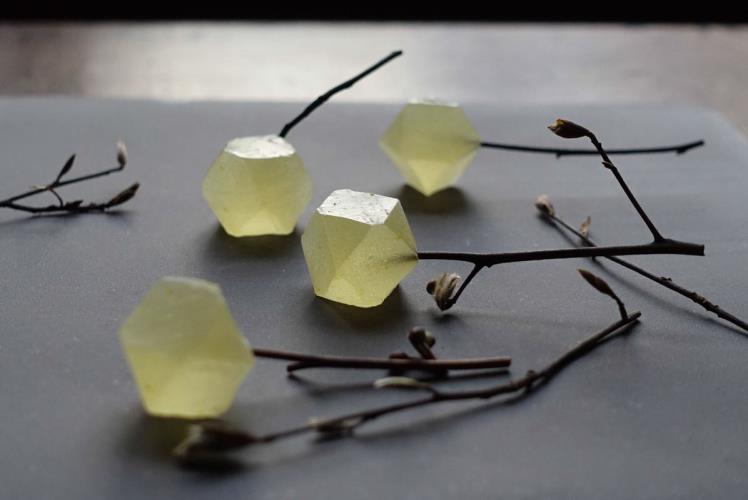Japan-based writer and traveller, specialising in design, lifestyle and travel journalism. Ron previously served as an editor of MING Magazine, ELLE Decoration and CREAM.

Speaking of wagashi, what comes into my mind is those flower or leaf shaped desserts in pink or light-green colour which are so sweet that they must be taken with tea. But in fact, there are many kinds of wagashi, mainly divided into raw, half raw and dried ones. The above mentioned wagashi in beautiful asthetic design is called the raw wagashi, which has very exceptional requirement of hand craftsmanship. It can be regarded as a piece of edible art that is more concerned about whether it can convey the artistic conception of seasonal changes rather than taste.
Futaba in Demachiyanagi is known for its light-savory bean cakes. There are always long queues every day. The Toraya Wagashi Café at the Ichijo-dori is also crowded for all time. But if you are careful enough, you could find out that most of the customers are middle and old-aged persons or travellers. It looks like that wagashi is more and more distant from the food culture of the young people.
What is the so-called food culture of the younger generation? In Japan, it is food that is very presentable before camera. This is also the same in Hong Kong and Macao. In recent years, young people in Japan are very fond of muffins fully covered with fruit and fresh cream, super sandwiches stuffed with colourful vegetables and chicken, ice creams with bright-coloured donuts. The most important selling point of these snacks is that they are very appealing in photos. It is not only the delicacies but also the beautiful pictures to be uploaded to Instagram that the younger generation desire, who are willing to queue for more than two hours in store.
In order to follow the trend, many wagashi brands are trying hard to break away from tradition to come up with unique packaging and presentation to attract the youngster. Earlier, the 0101 Department Store in Kyoto was refurnished. After its completion, wagashi shops took the place of bookstores on the first floor, selling all kinds of wagashi. Customers of 0101 are generally young people, so wagashi there is quite trendy and interesting. There is one shop called CoCo Color Kyoto, managed by Kyo Nishijin Kasho SOUZEN. Souzen Yamamoto, the owner, was born in a village where traditional rice cakes are produced. However, Yamamoto wished to make a breakthrough with great emphasis on product packaging to target the market for the young. The most popular product here is the stringed warabimochi. Warabimochi is usually served in a dish. Yamamoto simply strings them together with a bamboo stick, and then here comes the stringed warabimochi. Wrapped in an exquisite paper box, frozen Souzen-stringed warabimochi tastes like sobert, which immediately became the interviewee of Casa Brutus.
In Japan, there is wagashi called Rakugan, which is made of rice flour and three pots of sugar and compressed in wooden molds. In addition to taste, Rakugan plays great importance to its melting taste and beautiful appearance. Rakugan is often shaped in flowers or leaves and other seasonal images. Rakugan in Kyoto’s new stylish wagashi store, the UCHU wagashi, is also always associated with seasons but come up with more fascinating stories. For example, Fukiyose means something that comes from the wind. It has 24 different designs, such as birds, butterflies, music, stars, white clouds and so on. Each box of Fukiyose is randomly placed with five pieces of designs. What on earth does the wind roll for you? It's not known until you open the box.
Both the UCHU wagashi and Souzen are in pursuit of brand new concepts, but okashimaru, founded by Sayoko Sugiyama, sticks to tradition. Wagashi is normally thought to be sweet, but okashimaru also provides salty one and sometimes wagashi mixed with Chinese red pepper in an unique fragrance. On the other hand, the colour of its products is much darker than that of the market because it is all made of natural materials. The purple one is made of taro, the orange one is of pomelo, and the white one is of bean. Many people have mistaken okashimaru as new innovated wagashi. In fact, wagashi had two flavours, sweet and salty, and was also made of natural ingredients when it was introduced into Japan from China in Muromachi period. Sayoko Sugiyama just tried to reproduce the taste of that time.
Sayoko Sugiyama also pays special attention to the image of wagashi besides taste and materials. Most of wagashi are shaped in bamboos, flowers, birds or plants to coordinate with seasonal changes and nature, but her favourites are dandelions, minerals, the dawn, and so on, things that are much closer to us. “The Fruit of Ore" is one of the most discussed works of her. It is a kind of grapefruit-flavoured amber sugar wrapped in a thin crispy layer of sugar on top and stuffed with cold grapefruit, which is quite ordinary. Sayoko Sugiyama designed it in the shape of the ore forked with branches of the black camphor tree, which looks like the ore fruit in the tree, and it becomes very lovely then.
Food is the heritage of history and creativity. We get to know the culture of different periods from its taste and appearance. The new stylish wagashi is the creation of blending new concepts of modern people with essence in the past.